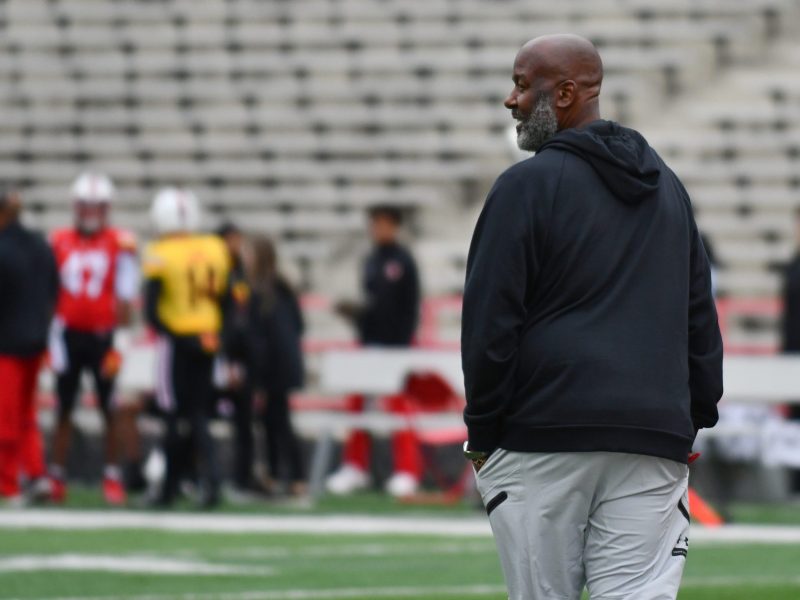There are profound differences in the way the University of Maryland and public data sources characterize college athletes’ performance in the name, image and likeness marketplace, according to an analysis by The Diamondback.
Changes to NCAA rules and state laws surrounding NIL went into effect in July 2021, allowing college athletes to make money off endorsements, appearances, merchandise and more for the first time. But nearly two years after making these changes, the NCAA has not established uniform laws or standards related to the NIL deal disclosure, leaving it up to a disparate set of stakeholders to decide what information becomes public, according to Mit Winter, an attorney who specializes in collegiate sports law.
The lack of NIL disclosure standards has made the task of cataloging deals accurately and comprehensively nearly impossible for independent aggregators.
A publicly accessible NIL deals tracker from On3.com, a media and data company covering college sports, listed a total of 37 deals with Maryland college athletes across six sports since NIL went into effect, according to an analysis by The Diamondback. By contrast, university athletics department spokesperson Jason Yellin said athletes have disclosed more than 1,100 deals to this university across 20 different sports.
The chasm between the two sources of Maryland’s NIL data illustrates broader transparency issues within the vast and unwieldy landscape of NIL.
Faith Masonius, a senior on the Maryland women’s basketball team, said the lack of complete, accurate and independently-verified data about NIL raises questions for athletes, ranging from what deals are permissible to how much to charge for an NIL deal.
“I’ve talked a lot with my teammates because sometimes they’ll be like, ‘Well, how much do you charge for an Instagram post?’” Masonius said. “It’s really just about talking to the people you’re working with and negotiating and knowing your value…and putting your foot down if you think you deserve more money.”
[Maryland gives coach Mike Locksley amended contract with average salary of $6.1 million]
On3 President Jeff Cravens acknowledged the company’s initial goal for developing its deals tracker may have been ambitious. Three reporters maintain the site’s tracker by cobbling together information from social media posts, brands, agents and other sources, but it is nearly impossible to account for the sheer volume of deals.
“We thought that deal tracker would be a little bit more comprehensive, but it is very difficult because there’s such a variety of deals out there,” Cravens said. “By no means do we think that’s anywhere close to comprehensive.”
The Hard Shell Collective, which consists of boosters who support the Maryland men’s lacrosse team, has 16 athlete deals listed through On3. But the collective’s website mentions partnerships with 23 athletes. On3 also leaves out deals athletes make for meet and greets, video shoutouts and other fan activities.
“We could probably have 20 people [contributing to the tracker] and still only get us a percentage of the deals,” Cravens said.
Restrictions on data disclosure compounds challenges for On3. Citing privacy considerations, athletes and their NIL partners sometimes write confidentiality provisions into the terms of their deals that keep their partnerships out of the public, Winter said. Some athletes also harbor concerns that too much disclosure could invite scrutiny from the NCAA, which has opposed athletes being able to profit off their NIL for decades.
[Key takeaways from UMD’s salaries report]
“One reason the NCAA is talking about wanting some sort of [NIL] database is so they can have more control over what’s going on,” Winter said. “They can see deals that are happening and potentially investigate some of those deals they are not fans of.”
Outside Maryland, some state governments are making it increasingly difficult to obtain a university’s NIL data, Winter said. In March 2022, Kentucky’s state legislature passed a bill that allowed some NIL deals to be exempt from public records requests, saying the information’s disclosure would constitute an invasion of privacy.
While public NIL data is limited across the board, The Diamondback’s analysis suggests that is particularly the case for female college athletes. Few players from this university’s women’s basketball team have been as prolific in the NIL market as Masonius, who has signed deals with Urban Outfitters and Steve Madden.
Yet On3’s tracker does not include any of the Terps captains’ NIL deals. While female college athletes like Masonius have made up 48 percent of all NIL deals disclosed to the university, women account for only 19 percent of Maryland’s deals listed in the On3 tracker.
According to Shannon Scovel, a journalism doctoral student who teaches a course on sports media and athlete branding at this university’s journalism college, reporters covering college sports often overlook female athletes’ performance in NIL.
View this post on Instagram
“Journalists represent women signing these enormous NIL deals – at least early, July 1, 2021 – as a surprise, as a shock, as the unexpected thing,” Scovel said. “[The coverage] would often be like, ‘You’ll never believe the leading NIL star is a women’s gymnast.’”
Scovel said making accurate NIL data more widely available would help the public better understand the value of women in the NIL marketplace.
But for Cravens, there is little optimism that complete disclosure is on the horizon.
“I just don’t think you’re ever going to get to a place – unless there’s a college athlete association or union – where that kind of deal data is commonly public across the board,” Cravens said.



